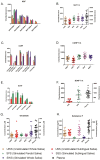Saliva as a medium to detect and measure biomarkers related to pain
- PMID: 29459715
- PMCID: PMC5818517
- DOI: 10.1038/s41598-018-21131-4
Saliva as a medium to detect and measure biomarkers related to pain
Abstract
Saliva is often neglected as a body fluid of diagnostic or prognostic value, even though generally well accepted by the patients. This is due to lack of a standardized collection procedure. The aim of this study was to identify the ideal saliva collection technique and develop new sensitive methods to detect and analyse markers related to pain in healthy pain-free subjects. Plasma and five different saliva collection approached was evaluated during strictly controlled conditions. Levels of nerve growth factor (NGF), calcitonin gene-related peptide (CGRP) and brain derived neurotropic factor (BDNF) were determined using novel western blotting based technology. Glutamate and substance P (SP) was determined using commercial available methods. Several new isoforms were found for NGF, CGRP and BDNF in saliva. The isoform pattern showed significant variation in both expression and chemiluminescence levels between different collection methods. New sensitive methods to study pain related markers in saliva were developed in this study. Furthermore, we are first to demonstrate a correlation between the Glutamate concentration in stimulated whole saliva and blood. However, the fundamental conclusion drawn is the importance of consistency in the collection method.
Conflict of interest statement
The authors declare no competing interests.
Figures


Similar articles
-
Topical review - salivary biomarkers in chronic muscle pain.Scand J Pain. 2022 Oct 14;23(1):3-13. doi: 10.1515/sjpain-2022-0112. Print 2023 Jan 27. Scand J Pain. 2022. PMID: 36228098
-
Daytime changes of salivary biomarkers involved in pain.J Oral Rehabil. 2020 Jul;47(7):843-850. doi: 10.1111/joor.12977. Epub 2020 Apr 20. J Oral Rehabil. 2020. PMID: 32277715
-
Altered levels of salivary and plasma pain related markers in temporomandibular disorders.J Headache Pain. 2020 Aug 26;21(1):105. doi: 10.1186/s10194-020-01160-z. J Headache Pain. 2020. PMID: 32842964 Free PMC article.
-
A possible role for saliva as a diagnostic fluid in patients with chronic pain.Semin Arthritis Rheum. 1998 Jun;27(6):348-59. doi: 10.1016/s0049-0172(98)80014-0. Semin Arthritis Rheum. 1998. PMID: 9662753 Review.
-
Acute effects of heavy resistance exercise on biomarkers of neuroendocrine-immune regulation in healthy adults: a systematic review.Exerc Immunol Rev. 2022;28:36-52. Exerc Immunol Rev. 2022. PMID: 35452397
Cited by
-
Toward Composite Pain Biomarkers of Neuropathic Pain-Focus on Peripheral Neuropathic Pain.Front Pain Res (Lausanne). 2022 May 11;3:869215. doi: 10.3389/fpain.2022.869215. eCollection 2022. Front Pain Res (Lausanne). 2022. PMID: 35634449 Free PMC article. Review.
-
Markers of Tissue Deterioration and Pain on Earth and in Space.J Pain Res. 2024 May 8;17:1683-1692. doi: 10.2147/JPR.S450180. eCollection 2024. J Pain Res. 2024. PMID: 38742243 Free PMC article.
-
Human Serum and Salivary Metabolomes: Diversity and Closeness.Int J Mol Sci. 2023 Nov 22;24(23):16603. doi: 10.3390/ijms242316603. Int J Mol Sci. 2023. PMID: 38068926 Free PMC article.
-
Evaluation of Potential Pain Biomarkers in Saliva and Pain Perception After Corneal Advanced Surface Ablation Surgery.Clin Ophthalmol. 2020 Mar 3;14:613-623. doi: 10.2147/OPTH.S225603. eCollection 2020. Clin Ophthalmol. 2020. PMID: 32184550 Free PMC article.
-
Psychological symptoms and salivary inflammatory biomarkers in patients with dentofacial deformities: a case-control study.Sci Rep. 2021 May 26;11(1):11083. doi: 10.1038/s41598-021-90721-6. Sci Rep. 2021. PMID: 34040126 Free PMC article.
References
-
- Castrillon EE, et al. Interstitial glutamate concentration is elevated in the masseter muscle of myofascial temporomandibular disorder patients. Journal of orofacial pain. 2010;24:350–360. - PubMed
-
- Shimada, A. et al. Increased pain and muscle glutamate concentration after single ingestion of monosodium glutamate by myofascial temporomandibular disorders patients. European journal of pain (London, England), 10.1002/ejp.874 (2016). - PubMed
Publication types
MeSH terms
Substances
LinkOut - more resources
Full Text Sources
Other Literature Sources
Medical
Research Materials

